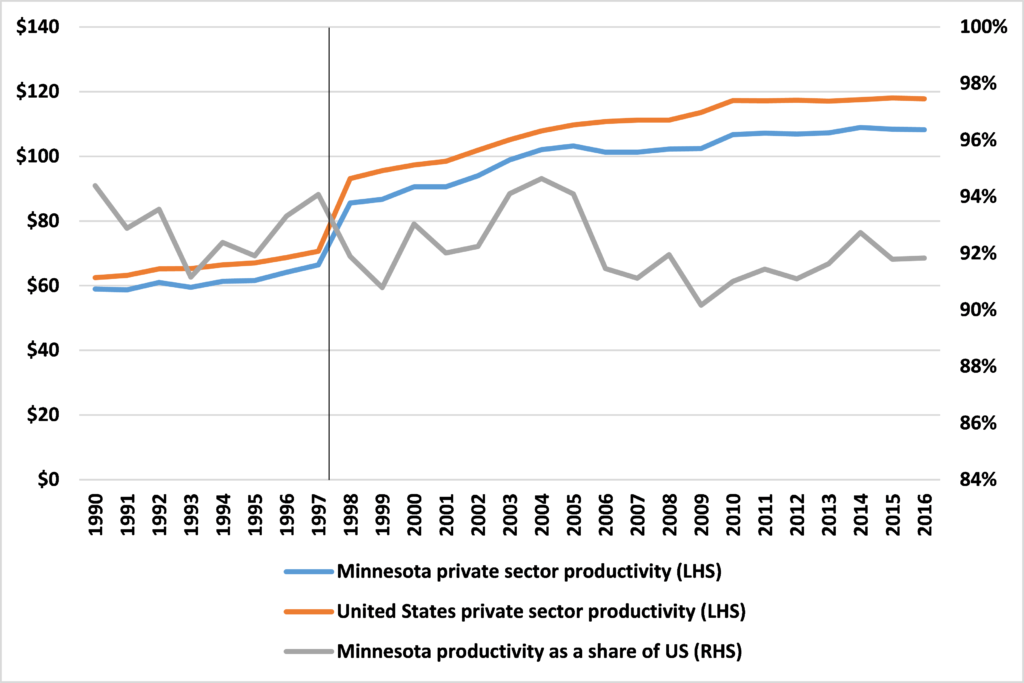Minnesota’s workers are less productive than the national average
In our new report, The State of Minnesota’s Economy: 2017, we take a thorough look at our state’s economic health and the prospects for the future. The second point we make is that Minnesota’s per-worker productivity has lagged that of the nation generally since 2000.
Minnesota’s productivity
As we’ve written before, productivity is, perhaps, the key to economic wellbeing. The ability to produce more outputs with a given amount of inputs is the essence of economic growth. This is not controversial. As the economist Paul Krugman has written
Productivity isn’t everything, but in the long run it is almost everything. A country’s ability to improve its standard of living over time depends almost entirely on its ability to raise its output per worker.
And he’s right.
That is why Minnesota’s relatively poor record on productivity is a concern. We can get an estimate of average productivity by dividing the amount of output in an economy by the amount of employment. This is what we do in Figure 1 (a version of which is Figure 2 in our report). Dividing private sector GDP by private sector employment for the US and Minnesota we see that Minnesota has lagged the national average since at least 1990. Furthermore, this gap widened in the mid-2000s, just prior to the Great Recession, and we now lag more than we used to. In 2004, the average Minnesotan worker produced 94.6% of the output of the average US worker. In 2016, that figure was 91.8%.
Figure 1: Private sector productivity, 1990 to 2016 (Real GDP per employee, 2009 dollars)

Source: Bureau of Economic Analysis and Bureau of Labor Statistics
Note: After 1997, the BEA measured GDP differently.
Of course, calculating per-worker productivity this way can be skewed by part-time workers. They count the same as full-time ones but work fewer hours and generally produce less. It can also obscure variation between different industrial sectors. Figures 2 and 3 take account of some of that (they correspond to Figures 3 and 4 in our report). Using data going back to 2007 on hours worked in the goods producing and private service providing sectors, we can calculate real GDP per hour worked.
As we see in Figure 2, Minnesota’s workers in goods production are less productive than the US average, producing 5.5% less GDP per hour worked. The gap has narrowed a little over time, but this is more a reflection of the poor performance on productivity nationally than any growth locally. Indeed, the average Minnesota goods producing worker’s productivity has stagnated for the last six years.
Figure 2: Goods producing productivity, 2007 to 2016 (Real GDP per hour worked, 2009 dollars)

Source: Bureau of Economic Analysis and Bureau of Labor Statistics
Figure 3 tells a similar story for the service providing sector. Here, too, Minnesota is below the national average, producing 7.6% less GDP per hour worked. But whereas productivity has more or less flat lined since 2010 in the goods producing sector, in services it has drifted downwards. This is bad news for Minnesota, as a growing share of the state’s jobs are to be found in service industries.
Figure 3: Service providing productivity, 2007 to 2016 (Real GDP per hour worked, 2009 dollars)

Source: Bureau of Economic Analysis and Bureau of Labor Statistics
Remember, productivity drives earnings. Minnesota’s below average per-worker productivity are a strong indicator of below average earnings down the line.
John Phelan is an economist at Center of the American Experiment.